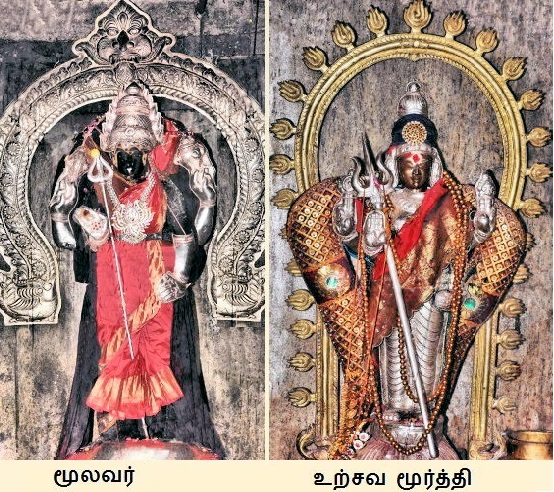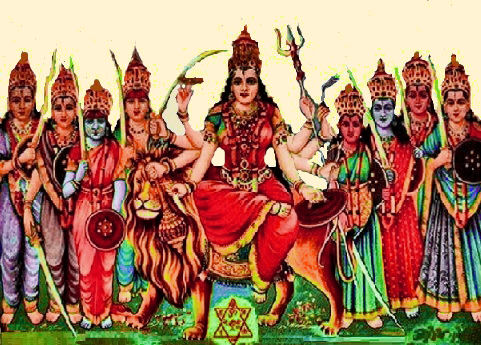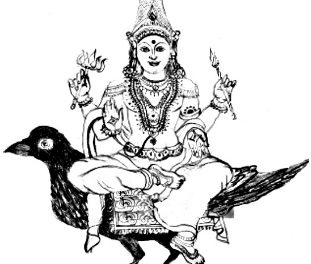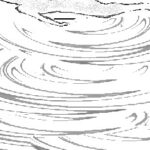
 Kathiramangalam Goddess Vana Durgai temple is in between Mayavaram and Kumbakonam. Situated 14 KM from Kumbakonam and 7 KM from Mayavaram the temple is stated to be as old as 2500 years.
Kathiramangalam Goddess Vana Durgai temple is in between Mayavaram and Kumbakonam. Situated 14 KM from Kumbakonam and 7 KM from Mayavaram the temple is stated to be as old as 2500 years. Kathiramangalam Goddess Vana Durgai is one of the nine temples in Nava Durga temples. The special Pooja for this temple is held during Raghu kalam on Sundays while on other days the Pooja is performed in normal time as in other temples. This is why the deity is called Raghu Kala Durgai in this temple. The temple has two unique features. First the deity faces east which is considered to be highly auspicious; secondly unlike in other temples where she is seen seated on a lion or on the body of a demon, Goddess Durga is seen here standing on lotus (Padma Peed ) and her appearance is also sober and calm. The height of the idol is six feet and the Goddess is called Goddess Vana Durga Parameswari Amman.
The 2500 years old temple is in the midst of a forest (now deforested) which was then known as Siva Vanam (Lord Shiva’s forest). Since the belief is that one of the Navagrahas bhagawan Raghu daily visit this shrine to offer prayers to Goddess Vana Durgai, the malefic effects of Raghu dosh will be diluted by offering prayers here at least once or twice during the period when one is afflicted with Raghu Dosha. Therefore those afflicted with Raghu dosha visit this temple to get rid of its ill effects.
Several lores circulate on the greatness of this temple. One of the lores have been that bhagawan Raghu used to daily visit this forest to pluck Jasmine flowers for daily Pooja performed by him to Lord Shiva. One day he chanced to see Goddess Vana Durga sitting in penance in the midst of the jungle. Goddess Vana Durga, incarnation of Goddess Parvathi was on penance after annihilating demon Mahishasura. Fed up with war and blood she came here and sat in tapas seeking reunion with her consort Lord Shiva in her original form as Goddess Parvathi and hence the penance. From this forest she daily went to Varanasi, took bath in Ganges and came back to again sit in tapas seeking reunion with her Lord. This was the daily chore she was maintaining and when Raghu Bhagwan came there to pluck flowers for his Pooja he chanced to see the Goddess in taps. He offered his oblations to her in silence and waited till she opened her eyes. Goddess Durga opened her eyes and got ready to proceed to Kashi as usual. She was surprised to see bhagawan Raghu standing there offering his oblation to her and inquired the purpose of his visit.
When bhagawan Raghu told her of his visit (to pluck Jasmine flowers for performing Shiva Pooja), she too narrated reason for her tapas here. Thereafter he took her consent to allow him perform pooja to her without disturbing her tapas when he came there for flowers. He further requested that after she reunite with her Lord, she should manifest in the same place where she sat in tapas (in a temple) in sober form to not only bless her devotees, but also enable him to continue his daily worship of her whenever he visited to take flowers for Shiva Pooja. She accepted his request and assured that she would manifest here at an appropriate time after unifying with her Lord. Thereafter he (bhagawan Raghu) could also remain her subordinate deity in the same temple and grace the devotees to get rid of the ill effects of him (Raghu Dosha) if they offered prayers to her in Raghu Kalam, the period under the command of bagawan Raghu thereby giving him too the due respect that he deserved. It is believed that Raghu bhagawan even today continue to daily visit this temple site to offer prayers to her and stay during Raghu Kalam to lessen the ill effects of him on devotees afflicted by Raghu Kalam. Hence the faith that those afflicted with Raghu Dosha, when they visit this temple and offer Pooja in Raghu Kala, the malefic effects of Raghu Dosha will wane away.
After Goddess Durga rejoined with Lord Shiva as Goddess Parvathi, she manifested in Kathiramangalam in the form of Goddess Durga in the same place where she penanced. Several thousand years later a temple came up for Goddess Vana Durga, incarnation of Goddess Parvathi.
The pundit tell us that Goddess Vana Durga temple is the appropriate temple to get rid of not only the ill effects of Raghu Dosha (ill effects), but also to send their prayer to their unknown tutelary deity. Those of the family whose tutelary deity is not known to them and offer prayers to Vana Durga in this temple, their prayers will be carried to their unknown tutelary deity by Goddess Vana Durga who knew who their deity was.
One may wonder why the Devi does not quickly reveal through some mystic means who their tutelary deity was. There is reason for it. The agony of the decedents of those who had committed the sin of neglecting the tutelary deity will automatically reflect on the souls of those who had committed the sins. Even though the decedents were not directly responsible for the sin of neglecting the worship of the tutelary deities, by punishing the decedents the departed souls awaiting rebirth will remain in restless unable to bear the sufferings of their family members. On ground the family members in distress will not be able to perform Karma to their ancestors whole heartily and therefore the benefits of the Karma will not reach the wandering souls that await better rebirth. They will remain poorly fed and in hunger on that day taking the cruel punishment in Yama Loga. Only when the souls are punished thus, will they will learn the lesson for neglecting and showing disrespect to their tutelary deities.
The well learned pundits explain the philosophy thus. Generally only the first generation in the family whose ancestors had committed the sin of neglecting the tutelary deity will bear the brunt of the deity since they are directly responsible to perform Karma or take part in Karma to the departed parents. Though the first descendants are not directly responsible for the sins committed by their parents, only when they are disturbed will the benefit of Karma performed by them remain insufficient and true benefits of Karma will not reach the souls that had committed the sin. At the same time the compassionate tutelary deities does not let the families of the innocents suffer for ever and ultimately ensure that their decedents are put to prosperity.The second aspect in indirectly punishing the decedents of those who disrespected their tutelary deities is to ensure that the curse needs to be wiped out by successive generations at the earliest so that the future generations will not suffer, instead prosper – a sort of sacrifice to be performed by the direct decedents of the sinners for the betterment of many in their generations. The decedents of those who had neglected the worship of their tutelary deities when attempt to atone the sins by visiting temples and praying their unknown tutelary deity, they are helped in all aspects by the tutelary deities.
When the family members whose tutelary deity is not known to them visit Goddess Vana Durga seeking her grace to identify their family deity, Goddess Vana Durga help them by acting as courier to forward the oblations of those members whose family deity is not known to them, thereby appeasing the anger of their family deity. Only Vana Durga has been empowered and created by the Paramathman from the energies of Goddess Parvathi to act in this manner in the Universe. Even though some other divine forces can help in identifying the tutelary deities not known to some of the families, the curse of the deity can be nullified only by Goddess Vana Durga, so opine the pundits. At appropriate time the family deity when fully pleased with the sincerity of the family members will reveal themselves to them.
The learned pundits and spiritual masters say that those who visit Tirukadaiyur to celebrate their 60th and 80th wedding anniversary should also visit the nearby Markandeya temple and then offer worship to Kathiramangalam Goddess Vana Durga to gain the entire benefits borne out of the function performed by them. What is the logic behind it? Read this lore.
Mrigundu Rishi and his wife Marudmati the childless couple prayed Lord Shiva to beget a son. They were given two options. The son to be born will have a shorter span of life on earth, but will be highly intelligent. Alternately a child of low intelligence will be born but will have a longer life. Sage Mrigundu chose a son of high intelligence and thus Markandeya was born, destined to die at the age of 12.
On the day of his destined death he was performing puja to Lord Shiva in Tirukadaiyur temple (The temple did not exist then and only the worship place was in open land). Lord Shiva had manifested in that place in the form of a Shiva lingam. The messengers of Lord Yama who came there to pick up the life of Markandeya were unable to take away his life because they could not go near the Shiva Linga as certain specific area surrounding the Shiva Ling was sanctified place and no negative forces can enter the area (This aspect only became sanctum in the temples where except the pundit who perform puja, others can not enter) unless Lord Shiva had wished them to enter. On seeing the Lord of servants of lord of death, Markandeya firmly hugged the Shiva ling refusing to go with them. When the Yama Ganas could not take away Markandeya who was performing puja, Lord Yama decided to go in person to bring Markandeya’s life.
Markandeya’s father Sage Mrigundu who was in Kathiramangalam forest praying at the site of the unknown female deity (It was actually Goddess Vana Durga who remained invisible then) when heard of Lord Yama’s decision he decided to somehow save his son from the clutches of death. He prayed to the unknown deity to save his son. Pleased with the sage Mrigundu’s prayer, Goddess Parvathi appeared before him in the form of Goddess Durga and advised him to reach Tirukadaiyur nearby and offer prayers to Lord Shiva who would then save his son. Thus the life of sage Markandeya was saved. The events leading to sage Markandeya getting saved from Lord Yama is narrated in the history of Tirukadaiyur Puran. From then on it became a norm for those visiting Tirukadaiyur to perform their 60th birthday ritual to also visit nearby temples of Sage Markandeya and Goddess Vana Durga to offer prayers lest entire benefit of the ritual performed by them on attaining the age of 60 will not be gained by them.
Who is Goddess Vana Durga and how did she manifest there?
During Vedic period, Mahishasura a powerful demon was harassing the entire universes. Armed with rare boon from Lord Brahma that he cannot be annihilated by anyone born in Universe, he unleashed terror with the able aid and assistance from another two cruel demons called Shumbha and Nishumba. Unable to resist torments of the demons who harassed devas, all of them went to Lord Brahma pleading for his intervention to save them. Since even Lord Brahma could not help them, he took them to Lord Mahavishnu seeking his help. When the entire fleet of deva forces reached Lord Mahavishnu, he was conversing with Lord Shiva. After listening to the tales of the horror and harassment from Mahishasura both Lord Vishnu’s and Lord Shiva’s face grew red in anger. From the energies of their anger came out a big flash of light.
Next moment a female deity carrying hoard of weapons in her hands came out from the flash of light and proclaimed that she was Goddess Durga manifested from the energies of Sakthi of Paramathman, and not born in universe as created by Lord Brahma. So she assured the divine forces that she manifested at the behest of Goddess Parvathi to vanquish demon Mahishasura who remained invincible till then. She wanted to protect the universe from the harassment of the demon Mahishasura and other demons. The devas gave a big applause and welcomed their protector and celebrated the occasion in relief and joy.

Armed with the strength and energies of gods, the multi armed Goddess Vana Durga in all fairness of beauty in the universe went to the Vindhya Mountains in the form of a beautiful girl and deliberately began wandering in the forest. The Asura forces saw the beautiful girl wandering alone in the garden, fell in her beauty and quickly brought demon Mahishasura who tried to catch her to take her along with him. The infuriated Devi quickly assembled her forces and waged a war on the demon forces. Goddess Vana Durga lifted her weapons and mounted her tiger. In the fierce fight that lasted for nine days, she annihilated the demon forces including the demon head Mahishasura who appeared in the form of a lion in disguise. Thus she attained the name Mahishasura + martini, i.e Mahishasuramardini destroyer of demon Mahishasura.
As per the Village lore, both Goddess Vana Durga and Mahishasuramardini are same aspects of Goddess Parvathi only and manifested to vanquish Mahishasura who was threatening the whole universe with the extraordinary boon received by him. Therefore she had to manifest from the energies of anger of Lord Shiva. After killing Mahishasura, furious Goddess Vana Durga’s anger did not subside and she began to portray different postures with demon Mahishasura lying in pool of blood under her feet. Wherever she went people worshiped her in the same posture that she displayed. Time passed. Her anger began to melt down as she felt frustrated with fight and war and desired to reunite with her consort Lord Shiva. Therefore she went to Kathiramangalam forest which was a dense forest area at that time. She chose the present temple site which was in those days called Shiva Malligai Vanam (forest of Jasmine trees where Lord Shiva used to stroll) and sat in penance seeking reunion with Lord Shiva after regaining her original form i.e Goddess Parvathi. As the time passed, she completely turned sober and calm. During her stay there she reportedly visited Kasi everyday in the night and came back early in the morning after taking bath in Ganges to continue her tapas.
There is yet another lore that describes the greatness of Goddess Vana Durga. Once upon a time celebrated Tamil poet Kamban was staying in a village near this forest. Since he was poor he had to live in a hut roof covered by thatch. Whenever he took up any important work he used to always pray Goddess Vana Durga, an unknown female deity there, unaware of the fact that Goddess Durga has only manifested there in the form of Goddess Vana Durga. He continued to offer prayer to the unknown statue lying in the forest. One day due to severe storm, the rooftop of his hut began to fly away in the night and he prayed to Goddess Vana Durga to save his hut and slept. Next day morning he was amazed to find that the rooftop of his hut has been well covered with thick layer of thatch made of paddy sheaf and realized that the miracle may have happened due to the grace of the unknown female deity whom he prayed the previous night. Thereafter he began to worship the unknown deity who gave happiness to him by calling her as Kathiramangala Devi which in Tamil meant Kathir (sheaf of paddy) + Devi (deity) + mangalam (happiness). Thus the forest area derived the name Kathiramangalam.
Another lore that tells the greatness of this temple is connected to sage Agasthya Muni. Once sage Agasthiya was proceeding to witness the marriage ceremony of Goddess Parvathi with Lord Shiva. On the way he reached Kathiramangalam and found that his passage was blocked by a demon. Sage Agasthiya could not proceed further as the demon was gigantic in physical structure and the sage was no match to win over him over to proceed as the demon possessed extraordinary strength by way of boons from the lords. As per the boon unless his opponent also possessed the same boon which gave them the same kind of strength, he can not be vanquished. Immediately Sage Agasthya prayed to the unknown Devi enshrined in the forest to save him from the demon. In click of moment the sage was endowed with enormous power to vanquish the demon and move forward to attend the wedding ceremony. As the overwhelmed sage was wonder struck as to how he got such a momental power to overpower the demon, Goddess Durga appeared before him to tell him that she only gave him the power to attend her wedding function and disappeared. Sage Agasthiya then realized that the Goddess enshrined in Kathiramangalam was Goddess Durga, manifestation of Goddess Parvathi who remained in tapas for reuniting with her Lord. Because she manifested as Durga in the forest area he enshrined the idol he installed her in the very same place (present temple site) in a small place with proper rituals and named her as Goddess Vana Durga and went away to Himalayas to attend to the wedding ceremony.
Time elapsed. Slowly the villagers began to realize the greatness of the deity Goddess Vana Durga through those who went in trance during village festivals and revealed the events that led to her manifestation in that place. The stories of those who experienced the unbelievable began to slowly spread as word of mouth stories through those who got into trance on functions or from the scholarly pundits who visited there. Thus the lore on Sage Agasthiya, Sage Mrigundu and Poet Kamban began to be told for generations. Realizing the greatness and power of the Goddess, first a hut with roof top made of sheaf of Paddy was erected and over a period of time a big temple has been constructed to enable devotees offer prayers and worship.
There is a hole above the roof top filled with sheaf of paddy (It has been constructed so) to symbolically show that the Goddess is still continuing her practice of visiting Kasi through air to take bath in river Ganges and return back as she was doing so when she was in tapas here. No sanctum for God Vinayanagar exists here to offer prayers before offering prayers to the prime deity as practiced in all other temples. This is because Lord Ganesha being the son of Goddess Parvathi felt that she alone should have the importance and since the place had been fully sanctified by her arduous tapas and he merged with her in this temple to accept the prayers instead of accepting the prayers of devotees independently. The most important aspect of Goddess Vana Durga has been that she is seen standing on a lotus flower, in sober form free of anger on face, instead of her usual appearance of seated on Lion or over the body of the demon whom she killed to save the universe.






Dear Sir,
It is good to here from your Article . Whether the above Article can be in Tamil Language Version where many users can easily understand. It is only a suggestion.
Please see it is also in tamil in the same website. Please see the Tamil articles
pranams sir for the wonderful article,
Sir, thank you very much for such a wonderful article on this deity. May I know the contact # of the temple or any of purohits in the temple. Thanks.